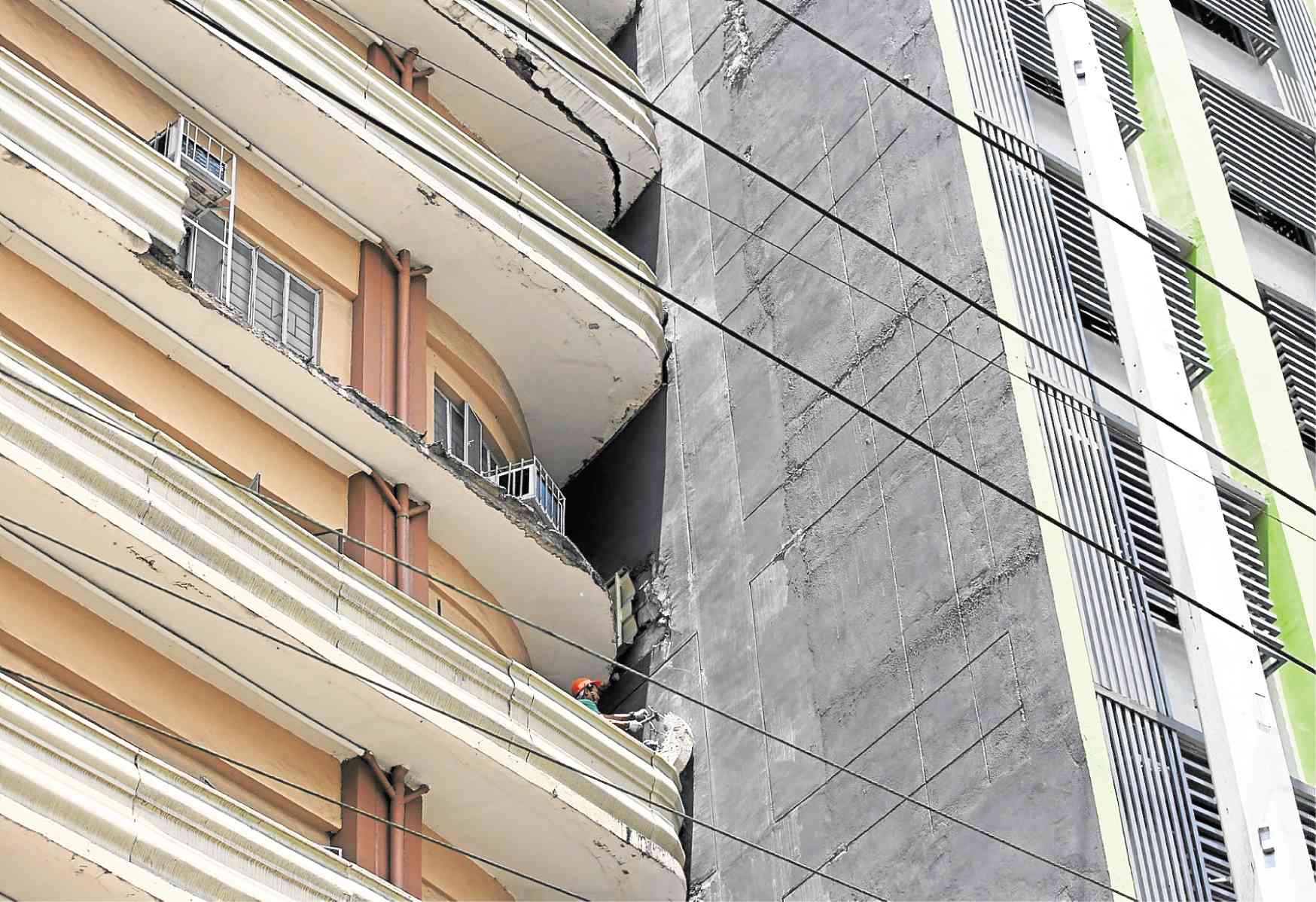Quake prompts inspections

TOO CLOSE FOR COMFORT Workers remove damaged fiberglass parapets—decorative ledges—from one of the buildings of Emilio Aguinaldo College on San Marcelino Street in Ermita, Manila. The 10-story structure appeared to have leaned into its next-door neighbor, a dormitory, following Monday’s quake. —LYN RILLON
MANILA, Philippines — The 6.1-magnitude earthquake that struck parts of Luzon on Monday has prompted several Metro Manila mayors to order an inspection of buildings and structures in their areas for any possible damage.
In Makati City, the country’s financial district, Mayor Abby Binay urged private establishments on Tuesday “to give their full cooperation” to teams of the Office of the Building Official (OBO) that will conduct a rapid damage assessment.
“All building management and administrators are strictly ordered to allow unimpeded access to the inspection teams and provide the needed information and cooperation to ensure a thorough and speedy assessment,” Binay said in a statement.
OBO records showed 197 high-rise buildings (16 stories or higher) which the city required to install earthquake-measuring instruments called seismographs.
Minor cracks
Article continues after this advertisementSo far, there have been no reports of damage to most of the city’s schools, except for minor cracks in some rooms and perimeter fences of Makati Science High School and La Paz Elementary School.
Article continues after this advertisementThe Makati Disaster Risk Reduction and Management Office activated its mobile command vehicle at the City Hall quadrangle to serve as incident command post.
In Manila, the City Engineer’s Office ordered officials of Emilio Aguinaldo College (EAC) to vacate one of their buildings “until further notice” pending an evaluation of the damage in the structure, which had noticeably leaned on a neighboring dormitory following the temblor.
Paulo Campos, EAC president, subsequently ordered the suspension of classes until next Monday to give way to an independent assessment of their five buildings on San Marcelino Street in Ermita.
One of the buildings—a 22-year-old, 10-story structure that houses most of the administrative offices and science classes—was observed to have leaned into the dormitory beside it.
Campos said the dormitory belonged to the Yap family, which owns Manila Bulletin.
City engineer Roger Legaspi rebutted misconceptions that the building was “nakasandal (leaning).”
“That was only a visual inflection,” Legaspi said, explaining that its structural column still appeared to be straight.
Months to assess damage
Campos said it could take months for engineers to assess the building’s structural integrity.
“We were told that the (far-left column) of our building dipped a little during the quake which could have caused the damage, though that is easily remedied by adding concrete under the foundation,” he added.
Legaspi and EAC engineering head Lilia Calulot said that what was damaged were the fiberglass parapets—decorative ledges meant to catch the air-conditioning units’ condensation.
Calulot pointed out that the building and dormitory had always been touching, though it was not clear if this was a construction flaw or a deliberate move to maximize lot space.
She said EAC was never consulted about the dormitory’s construction in 2016.
The buildings’ proximity also raised questions about whether the city government had been lax in enforcing the National Building Code, which could mean grave consequences in times of disaster.
Under the code, buildings that abut on each other’s property lines must have a space of at least 150 millimeters (around six inches) between firewalls.
Legaspi claimed that the columns of both buildings were 1 meter away from each other.
Only the EAC parapets suffered the biggest damage, he said, adding: “Even if you take that out, the building would stand on its own.”
The college has hired two independent firms to help with the postquake damage assessment, Campos said. They were asked to submit their reports as soon as possible.
No major incident
The Taguig local government said it was still checking for damage in structures in the city although it assured residents that “no major incident was reported” due to the quake.
Videos in social media showed the 48-story Net Park Building on 5th Avenue in Bonifacio Global City suddenly spouting a “waterfall” after a large volume of water fell from the roof.
In a statement, building developer Net Group said the incident was caused by the rupture of an external fiberglass roof-deck water tank.
“This caused water to cascade over the side of the building. The water was absorbed by the green roofs located on the 8th floor. The flow of water was immediately contained within 10 minutes,” it pointed out.
The quake that rocked Metro Manila and damaged parts of Central Luzon renewed public concern about the “Big One,” a hypothetical 7.2-magnitude earthquake due to the movement of the West Valley Fault.
According to the Metropolitan Manila Earthquake Impact Reduction Study in 2004, such a quake would destroy at least 40 percent of all residential structures in the metropolis and cause 34,000 deaths.